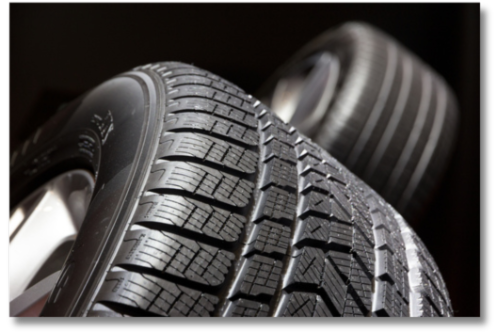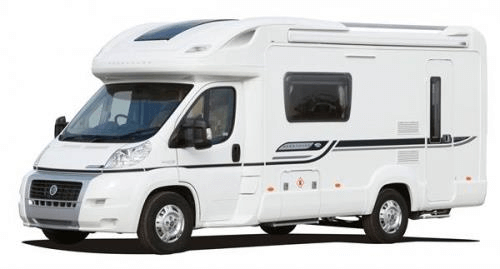There’s nothing quite like the freedom of the open road, the thrill of a new destination on the...
Being totally honest, how often do you think about your motorhome’s tyres, outside of the usual MOT and servicing regime? Chances are, it’s not until you’ve had a puncture or something’s come up as an advisory that you take more than a passing glance when putting air in. Yet, your tyres play a crucial role in the performance and safety of your motorhome, so it’s worth getting the right ones and then looking after them to prolong their lifespan. Here's our guide to everything you need to know about motorhome tyres to help maximise your on-road experience.
How do I know what motorhome tyres I need - and could I opt for commercial tyres instead?
Like car tyres, motorhome tyres come in a multitude of different sizes, load capacities and speed ratings, so understanding your motorhome's tyre specifications is essential for selecting the right tyres that can safely support the weight of your vehicle and provide optimal performance. The type and size of tyres will be specified by the manufacturer, taking into account the vehicle and the loading, so consult your motorhome's manual or seek guidance from a tyre specialist to ensure you choose tyres that meet your vehicle's requirements.
Motorhome tyres can be quite expensive, yet there is an alternative, as on many occasions you might be able to use commercial tyres. Commercial van tyres can be quite a bit cheaper, however whilst it’s ok to fit commercial van tyres to a motorhome (providing they are the correct size and load rating) you might not get all the benefits a specialist motorhome tyre will give you, which may include longevity and fuel economy. Motorhome tyres have tougher sidewalls which not only makes them better at running at the high pressure needed for a fully-loaded motorhome, but this also gives them more rigidity for a safer, more stable drive and better handling on the road.
It goes without saying that you should stick to the same type of tyre across the vehicle. Most modern tyres are the radial type, although you may still find some cross-ply ones out there. It’s important to note that you shouldn’t mix both on the same axle, as they behave quite differently under load.
What do the tyre markings mean?
If you see ‘CP’ written after the rim diameter code, this depicts a commercial vehicle tyre for use on a motorhome. A ‘C’ stands for a standard light commercial tyre. Generally, ‘CP' marked tyres are recommended for most motorhomes that aren’t van conversions, and ‘C’ marked tyres are generally used for the latter, however it does seem that many secondhand motorhomes seen on the market do have ‘C’ tyres fitted these days. ‘CP’ tyres have a higher load index and pressure as well as a reinforced carcass, which can help with uneven distribution from the contents of the motorhome and potentially the overhang, so may be more suitable for coach built motorhomes. In terms of what you type of tyre you choose to have, it’s up to you, really, unless the motorhome manufacturer strongly suggests otherwise.
There are a couple of other things to look out for. If you see a logo with a mountain on it - the three-peak mountain snowflake - this shows it is a winter or snow tyre. Some tyres may be marked with ‘M+S’, which signifies that, according to the manufacturer at least, it is suitable for mud and snow.
Tyres also have a date stamp, written on the sidewall, so do keep an eye on this piece of information. Some motorhome insurance companies won’t cover tyre-related claims if the tyre is over five years old and you can’t prove they’ve been annually inspected by a competent person. Tyres made since 2000 have a four digit code on them - the first two digits depict the week of manufacture, the second two depict the year. So, if you see 0412, that tyre was made in week four of 2012.
The British Tyre Manufacturers’ Association states that any tyre over seven years old should not be used on a motorhome.

Tread and wear - beware!
The tread depth of your motorhome tyres directly impacts traction, braking performance and handling in various road conditions. Insufficient tread depth can compromise safety, especially on wet or slippery surfaces. Monitor your tread wear regularly and replace tyres when the tread depth approaches the legal minimum depth or if signs of uneven wear patterns, such as cupping or feathering, are observed. As with car tyres, the UK minimum legal tread depth is 1.6mm but it’s generally recommended you replace any tyres below 3 mm. In some colder European countries it is sometimes compulsory to have a minimum tread depth for winter tyres, so do check this before setting off abroad in the colder months.
A really important point to note is that although it might not show up as an MOT failure, or may be just an advisory, you may still have perished tyres on your hands if the walls of the tyre are cracked or damaged - so don’t take the pass result of an MOT as evidence that there is nothing wrong at all with your tyres.
Proper inflation and maintenance
Maintaining proper tyre inflation is crucial for tyre longevity, fuel efficiency and safety. Under-inflated tyres can lead to increased rolling resistance, uneven wear, and decreased handling, while overinflated tyres may result in reduced traction and ride comfort. Check your tyre pressures regularly - ideally monthly at least - and always before a long journey.
It’s interesting that the markings on the sidewall of the actual tyre that indicate the maximum load and the maximum pressure may not necessarily be the load and pressure values for your vehicle - for this, refer to the inflation pressures suggested by the vehicle’s manufacturer.
As with cars, check the pressure when the tyre is cold as the pressure will rise once the tyre gets warmer. If not already fitted, you can buy a tyre pressure monitoring system which will warn you if any tyres are getting low. Always make sure they are inflated to the correct pressure - note that the rear axle tyre pressure may well be different to that of the front so do check the motorhome manufacturer’s guidance on that.
Motorhomes are designed to carry significant loads, including passengers, supplies, and equipment. The load index of a tyre indicates the maximum weight it can support when properly inflated, so it’s crucial to distribute weight evenly across all tyres to prevent overloading and maintain stability while driving.
When checking your tyres, remove any trapped items such as stones, and check for cuts and cracks and any bulges on the walls and tread. If you see these, you’d be wise to get the tyres checked out asap. Do regularly inspect them - no-one wants to be caught in a tyre blowout, and without safe tyres you really can’t brake, steer and take corners safely otherwise.
Finally, if you are upgrading, or changing a certain number of tyres but not all of them, it’s usually a good idea to put your newest tyres on the back axle, as the bulk of the power is given from the rear - and therefore move the existing back ones forward to the front. Do check this applies to your particular motorhome though, as some all-wheel drive vehicles should have all their tyres periodically rotated for even wear.
Thinking about the weather
Motorhome travel obviously involves journeys in various weather conditions and on all terrains. You might want to consider all-season tyres that can provide adequate performance across many different weather conditions, including snow, rain, and dry roads. Tyres in the UK are generally summer tyres, useful for most conditions, although you can also get winter tyres if need be.The tread properties on winter tyres remain softer at lower temperatures and maintain a better grip, so bear this in mind for the colder months.
Ensure your tyres are suitable for the environments you'll encounter during your travels to maintain safety and year-round performance. Do act to protect your motorhome tyres from excessive exposure to the sun, however, because UV rays and heat can accelerating the premature ageing of tyres - there are tyre covers that you can buy to help prevent this.
We all need spare tyres (ideally on our vehicles, not round our waists)
Don't overlook the importance of a spare tyre! As we said above, check the date on this one too, as this can often get overlooked. You should also look to carry a tyre pressure gauge and emergency tools including a jack for any tyre-related incidents. Keep your spare tyre inflated to the maximum pressure at all times, and remember that spare tyres are not checked during an MOT so you will need to do all of those checks yourself (or ask a garage to).
So there we have it - hopefully that wasn’t too tiresome (sorry). It’s pretty clear that prioritising the maintenance and care of your motorhome tyres is essential for safe and enjoyable travels. By understanding the different tyre specifications, monitoring tread wear, maintaining proper inflation and taking into consideration seasonal needs, you can be confident that your motorhome tyres will be up to the task all year round.




.jpg)



